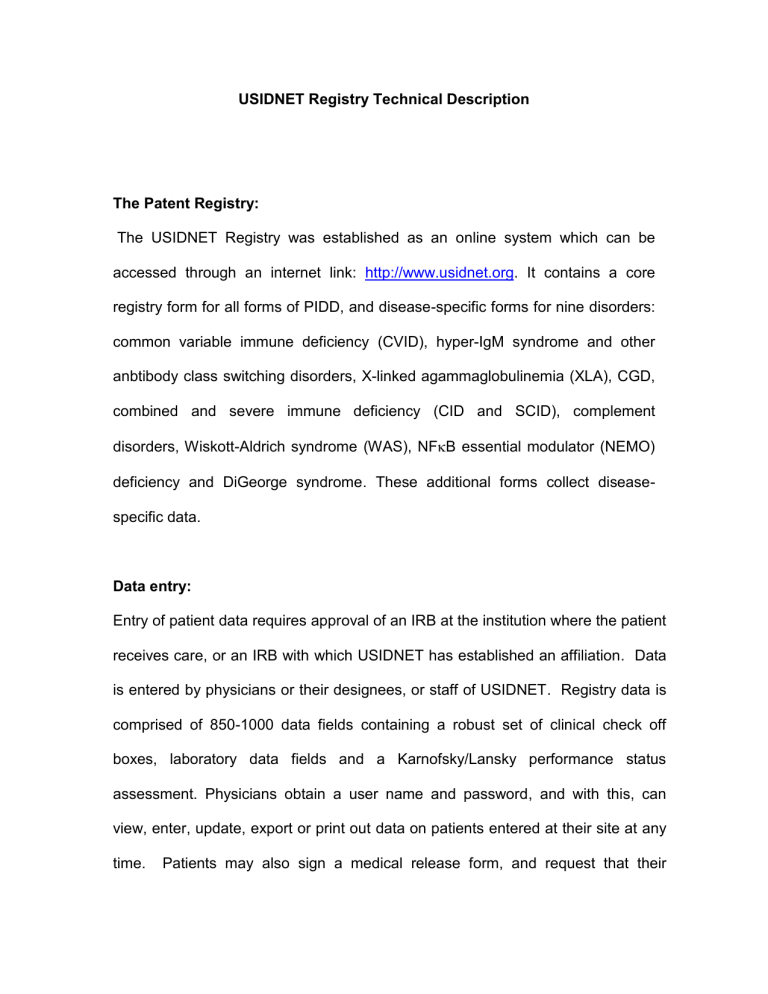USIDNET Registry Technical Description The Patent Registry: The

USIDNET Registry Technical Description
The Patent Registry:
The USIDNET Registry was established as an online system which can be accessed through an internet link: http://www.usidnet.org
. It contains a core registry form for all forms of PIDD, and disease-specific forms for nine disorders: common variable immune deficiency (CVID), hyper-IgM syndrome and other anbtibody class switching disorders, X-linked agammaglobulinemia (XLA), CGD, combined and severe immune deficiency (CID and SCID), complement disorders, Wiskott-Aldrich syndrome (WAS), NF
B essential modulator (NEMO) deficiency and DiGeorge syndrome. These additional forms collect diseasespecific data.
Data entry:
Entry of patient data requires approval of an IRB at the institution where the patient receives care, or an IRB with which USIDNET has established an affiliation. Data is entered by physicians or their designees, or staff of USIDNET. Registry data is comprised of 850-1000 data fields containing a robust set of clinical check off boxes, laboratory data fields and a Karnofsky/Lansky performance status assessment. Physicians obtain a user name and password, and with this, can view, enter, update, export or print out data on patients entered at their site at any time. Patients may also sign a medical release form, and request that their
medical records be sent to USIDNET, to be entered by a trained abstractor.
Moreover, quality of life data can be entered directly by the patient. An assessment regarding how the diagnosis was established is requested for the nine disorders with disease-specific forms. The quality of life data is linked to the medical data for each patient. Data changes are tracked through data audit records.
Data use
The system provides methods for data extraction and reporting through SQL
Server Reporting Services, Inc., and by the Registry Manager for all Registry patients, as well as categories of patients, such as by diagnosis or by entry site.
An ad-hoc reporting tool enables enrolling physicians to view, or filter their own patients’ data, by disease, gender or other criteria, to produce reports that can be exported to Excel or other file formats.
An important aspect of the Registry is the ability to answer queries.
Anyone may submit a request for de-identified data from the entire Registry.
Queries may be simple or complex, having to do with overall outcomes, specific data fields, or groups of subjects with one condition. The USIDNET web site supplies the query form on which the question is outlined, along with the parameters and disease categories of interest. Queries are vetted by the
Registry Manager and Disease Specific Working Groups and the USIDNET
Steering Committee as needed.
Security:
The USIDNET Registry database was built in ASP.NET / C# on a .NET 2.0
Framework with two SQL Server databases. Protected patient and physician demographic information is stored in one database, while a secondary database stores all other captured data points. The two databases are linked by a unique code number for each individual. The website is protected by Secure Socket
Layer (SSL) technology, which provides encryption of information passing through the Internet.





